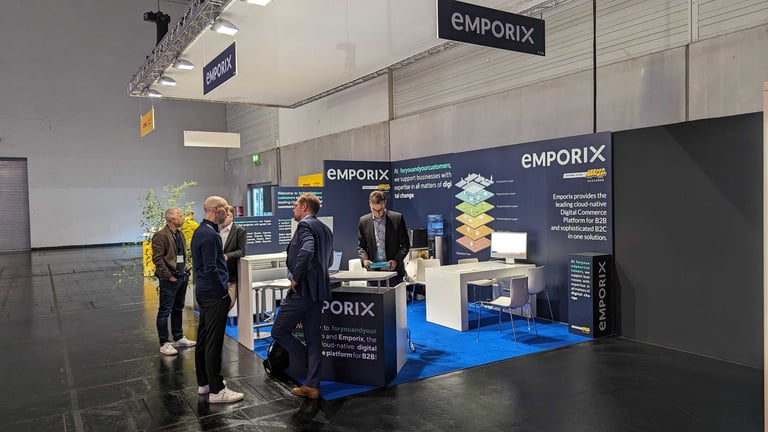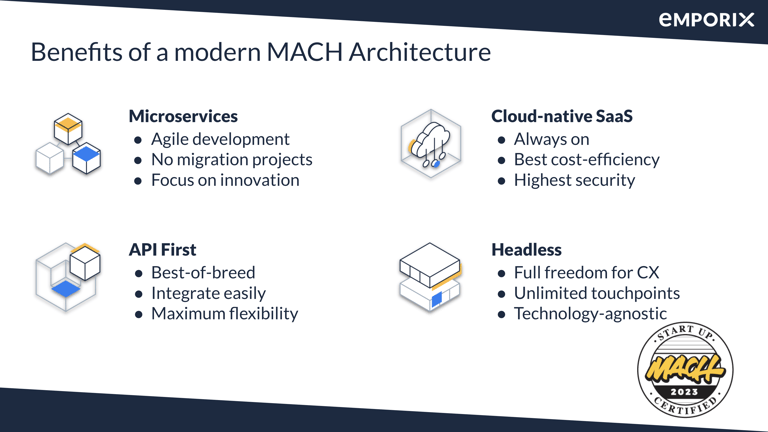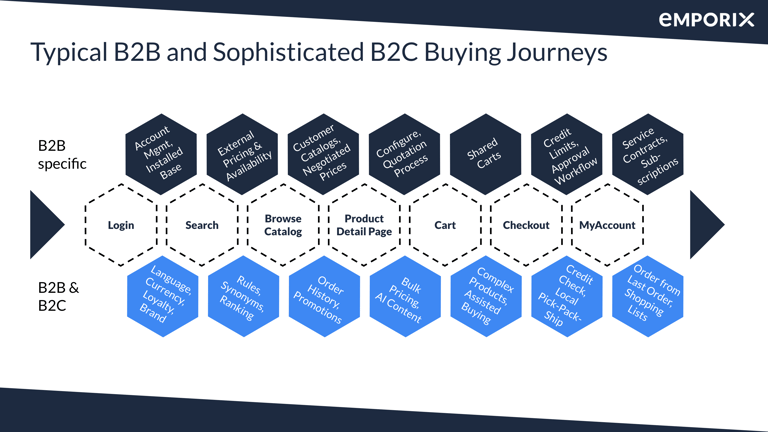How to successfully orchestrate best-of-breed technologies in B2B commerce
The days of monolithic software systems in B2B and sophisticated B2C commerce are over. Find out here where the technology journey is headed and what role cloud-native composable commerce platforms like Emporix play in it.
Gartner pointed out back in 2014 that flexibility plays a decisive role in the future viability of companies. This refers to the flexibility to adapt to new requirements in real time and to develop resilience towards uncertainties. This insight has given rise to the idea of the Composable Business, a concept that focuses on modular structures and the orchestration of technologies.
„Composable Business is a business that consists of interchangeable building blocks. These building blocks enable companies to quickly transform.“ - Gartner
In their keynote presentation at DMEXCO 2023, Eberhardt Weber, CEO of Emporix, and Axel Helbig, CEO at foryouandyourcustomers, demonstrated how the principle of Composable Business has been successfully applied to the field of e-commerce technology in recent years. With composable commerce platforms like Emporix, companies today can flexibly orchestrate best-of-breed technologies.
TL;DR
-
Monolithic software systems are reaching their limits in terms of adaptability and scalability in B2B and sophisticated B2C commerce.
-
The perpetual need for migration projects with traditional systems keeps valuable resources away from innovation.
-
Composable commerce platforms, unlike monolithic systems, are designed for agile change and adaptation.
-
The MACH principles of Microservices-based, API-first, Cloud-native SaaS, and Headless lay the technological foundation for composable commerce.
-
Composable commerce platforms such as Emporix are particularly suitable for complex business processes that standard commerce solutions cannot support.
The evolution of e-commerce systems
E-commerce technologies are evolving at a rapid pace. Whereas monolithic all-in-one systems dominated digital commerce just 20 years ago, today we see a clear trend toward systems that enable greater modularity and flexibility. Today, rigid, prefabricated solutions are being replaced by agile structures that allow the best solutions for specific needs - best-of-breed - to be individually orchestrated.
The reasons for this development are obvious: Most of the leading e-commerce solutions that still dominate the market today were developed decades ago. At a time when the demands on the flexibility and adaptability of digital commerce were not as challenging as they are today. No wonder that such systems, even if they pretend to be composable, have their limits.
Monolithic systems are generally not designed for change. As a result, innovations can only be implemented slowly and with significant effort. Peak loads in operation cannot be flexibly absorbed because the system lacks scalability. In order to guarantee a perfect shopping experience at all times, more server capacity is required, which leads to costly overcapacity during regular operation.
Further downsides of monolithic systems result from the dependency on the vendor, who dictates the rhythm and scope of software updates. On the one hand, updates often lack business value, but still cost a lot of money. On the other hand, companies often wait a long time for important innovations that would be urgently needed for competitive e-commerce - both are negative consequences of the vendor lock-in.
Last but not least, monolithic e-commerce systems can be very complex and costly to operate and develop. The more complex and individual the business, the higher the total cost of ownership (TCO) for technologies that are not designed for change and adaptation to new requirements. Incidentally, this also applies to monolithic systems where the front end and back end are decoupled according to the headless principle.
“For monolithic e-commerce systems that are not designed to change and adapt, migrating new features and processes takes 20-50% of development resources.” - Eberhardt Weber, CEO at Emporix
Benefits of a MACH-based Composable Commerce Architecture
Gartner defines Composable Commerce as an architectural approach to digital commerce in which applications are implemented using Packaged Business Capabilities (PBCs). PBCs are software components that represent a clearly defined business capability. Here, too, it is worth taking a closer look, as PBCs are always modular, but not necessarily built in a truly modern way, i.e., based on microservices within the framework of a service-oriented architecture (SOA).
Worth reading: All You Need to Know About Composable Commerce
The technological requirements for Composable Commerce are reflected in the so-called MACH principles: Microservices-based, API-First, Cloud-native SaaS and Headless. True Composable Commerce platforms support all of these four principles, since only in combination do they enable enterprises to flexibly orchestrate best-of-breed solutions and publish critical functionality in real time.
In summary, composable commerce platforms based on a MACH architecture are designed for agile change and adaptation, unlike monolithic systems. This allows innovations to be implemented more quickly and easily. The modular architecture reduces the complexity of the individual system components and thus also the risk in development, as test routines are less complex and individual building blocks can be easily replaced or supplemented.
Example: Managing the Buyer Journey in B2B and sophisticated B2C with Composable Commerce
Composable commerce platforms such as Emporix are particularly suitable for complex business processes that standard commerce solutions cannot handle or only to a limited extent. Such complex processes can be found in all phases of the buyer journey in B2B and in sophisticated B2C - from login, search and catalog to cart and checkout. The following chart exemplifies typical functional requirements.
With a composable commerce architecture, companies are able to add critical capabilities for each phase of the buyer journey in real time, or replace obsolete ones as requirements change or new opportunities arise from technical innovation. Both best-of-breed components available on the market and self-developed services can be deployed and combined.
“80-120 channels across the enterprise require a commerce architecture that enables digital capabilities, data and domains to be orchestrated flexibly and in real time.” - Axel Helbig, CEO at foryouandyourcustomers
When moving from a monolithic legacy system to a composable commerce platform, it is essential to not only rethink technology, but also to transform the company as a whole - organization, processes, data, assets, all the way to culture - towards a composable business. Technology can be a key driver and compass for this change process.
Worth reading: The Exploded View model by foryouandyourcustomers visualizes the deeper interrelationships and challenges in the company and makes them more comprehensible.



